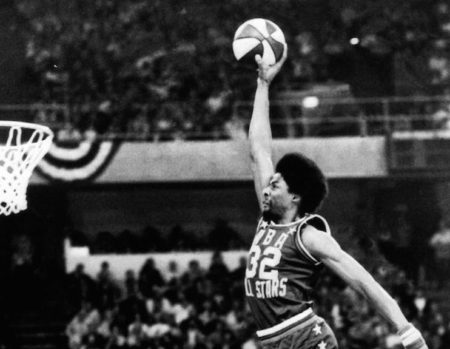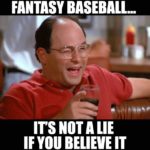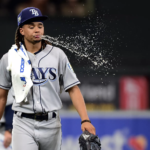Hard and Harder: Must-Watch Television
 This is a baseball column, but sometimes it’s easier to make a point by reaching outside the sport. And in this case, basketball’s version of must-watch television comes to mind.
This is a baseball column, but sometimes it’s easier to make a point by reaching outside the sport. And in this case, basketball’s version of must-watch television comes to mind.
Especially, its 10-foot basketball hoop.
Julius Erving’s Flight to the Basket
Fifty years ago, NBA players were smaller, not as quick, or lithe. Julius Erving was the first of the truly gifted athletic talents to enter the NBA (actually he spent his first five seasons in the ABA winning several championships before joining the Philadelphia 76ers in 1976). He brought extraordinary skills to the NBA that included superb leaping ability.
Dr. J, as was his nickname, was the first player to popularize the “slam dunk.” After Erving, the slam dunk became the move in the league. And in 1984, the league began the Slam Dunk contest at the All-Star game, institutionalizing not only the dunk, but the stylized dance to the basket that different players choreographed before slamming the ball into the hoop.
The NBA had changed, and without thinking about it, its newer players had enabled the 10-foot basket to become an even more powerful platform. For players began to develop their own stylized athleticism, rising one to two feet over the rim before allowing gravity to assist their powerful release, violently jamming the ball through the hoop.
Dr. J was a sight to behold when soaring through the air to the basket, beginning his ascent at the foul line. His right arm elongated into the air making the ball seem like a tiny orb in his huge fingers as he wielded it high above his head. At the apex of his jump, his arm gradually swung down, and in perfect harmony, hand, ball and basketball hoop all merged in the same time and space. The ball flew through the hoop with an artistic frenzy. The new artistry of the NBA was on display for all to see.
The NBA Would Never be the Same Again
This fluid, almost liquid attack on the rim would become the new standard. Throw it down with force and determination, like throwing a brick through a plate glass window. Players like George Gervin, Larry Nance and Michael Jordan followed Dr. J and spiced up his maneuvers with spins and twists of their own. And the NBA would never be the same again.
Hard and harder came soon enough with the arrival of Chocolate Thunder into the league in 1975, straight from high school. Darryl Dawkins was a massive man, even by NBA standards. And while Dr. J was an artist, Dr. Dunk was like a brick to a plate glass window.
For Dr. Dunk, bigger and stronger, the dunk was too easy, and he went overboard. By the late 1970s he was destroying glass backboards when he dunked. Until the NBA took action. Dawkins was Mr. Hard and harder, personified.
The NBA had become a league of superb athletic talents for whom a 10-foot basket was a joke. Too easy. The NBA did not change the terms of the game. It did not raise the basket to 13 feet. It did not want to fiddle with success. And more and more money.
So, the NBA decided to let the athletically gifted continue to dominate the game at 10 feet. Not higher and higher, but easier and easier.
What does this have to do with baseball? The NBA is yet another example of a sport that has cheapened its product for television, which loves to show rousing dunks from all angles. At 10 feet.
The same way baseball on television has become all about rousing home runs and crowd-pleasing strikeouts. In short, about hard-thrown and hard-hit balls. That’s what counts. Hard and harder. Farther and farther. Bigger and stronger.
And faster, of course. A lot faster.
Must-Watch Television: The Allure of the Long Fly Ball
On Yankee broadcasts, Michael Kay calls just about every Aaron Judge at-bat must-watch television. He said the same about Gary Sanchez at-bats his first season and a half with the Yankees when Sanchez was smoking balls out of the stadium regularly.
Like don’t miss this dunk, don’t miss this moonshot, or your life will never be the same again. That’s the media message.
The allure of a long, fly ball launched into the stratosphere by a fearsome hitter keeps eyeballs glued on the game. And there are so many sluggers in baseball now. Quick, easy points, or runs. Which is why so many teams live or die by the home run in today’s baseball.
Home runs and swinging hard, and harder, are the baseball equivalent of slam dunks. All or nothing. Swinging for the downs every at-bat. Throwing the ball down with force. Big Money.
Big sluggers are uncaring of strikeouts, even though strikeouts are the most unproductive outs in baseball.
In today’s baseball, the best teams are loaded with power hitters throughout the lineup, and around the diamond. Averaging 1 to 1.5 home runs per game.
Go back to the 1950s when Ernie Banks was the only shortstop in baseball who blasted home runs as if he were a left fielder (until his age thirties when he moved to first base after he could no longer play shortstop). Now, many shortstops are home run hitters. Francisco Lindor. Carlos Correa. Xander Bogaerts. Didi Gregorious. Trevor Story. Javier Baez. Corey Seager, and others.
The same can be said of the plethora of power-hitting second baseman, a position that once featured light-hitting, lithe defensive specialists.
Only among catchers is there a dearth of home run hitting today. That could be expanded to say catchers’ hitting in general. The best hitting catchers? J. T. Realmuto. Buster Posey. Salvador Perez. Gary Sanchez (who had a horrible 2018). And Yadier Molina. But none of them scare opponents, although when Gary Sanchez is right, he can be fearsome.
Home Runs are Big Money
So, a team like the Minnesota Twins, who did not feature even one 30-plus home run hitter last season, has now added two sluggers to their lineup for the 2019 season. Nelson Cruz signed a one-year contract (with an option year) that should bring hard and harder to the fans in Minnesota. A lot of it. Combined with C. J. Cron (secured on the cheap), that’s a lot of thunder in the middle of the Minnesota lineup to replace the recently retired Joe Mauer.
A lot of slam dunks added to a lineup that lacked pizzazz in 2018. It doesn’t mean Minnesota will overtake Cleveland, with even less of a chance that they will be the wildcard. But they should be a more exciting team in 2019. Maybe they will dunk enough balls over fences to give Cleveland a run for its money.
The allure of home runs could promise a business bonanza for Minnesota. More season ticket holders and increased revenues at the game. Beer sales. Parking. Merchandising revenues from the sale of Cruz and Cron uniforms. Perhaps even an increase in cable television viewership that translates into greater advertising revenue for the team as the Twins become must-see television in the upper Midwest.
This is Baseball Today
Fans waiting for the sluggers on their favorite teams to mash a home run. Fans at the games, fans on television and fans streaming games over the Internet. Many thick streams of revenue.
So much revenue that even small-market teams like Minnesota can find bargains (like C.J. Cron), or reasonable free agents (like Nelson Cruz) to field a formidable team.
And this is why the home run, the slam dunk, have changed the nature of these sports. Less strategy and teamwork. More cheap thrills. And of course, the point of it all, a lot more money in ownership’s pockets. Since no matter how much the players earn, it pales in comparison to ownership’s yearly haul.
Hundreds of millions, if not billions, a year in profits.
And since ownership does not publicize their revenue, fans have no idea what the big boys are making. And that’s why ownership is content to let the game degenerate into a boring home run, strikeout contest. It’s easier, and besides, they win either way.

























